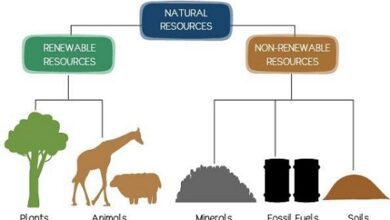What is global warming causes greenhouse effect and Consequences
What Is Global Warming?
Global warming is a phenomenon that has been registered around the world during the last decades.
It refers to a progressive increase in the average temperatures of the oceans and the Earth’s atmosphere , which has consequences for flora and fauna, in addition to impacting critical sectors such as agribusiness.
This warming is caused by the greenhouse effect, a phenomenon first described in 1859 by Irish scientist John Tyndall .
Although the greenhouse effect is natural, it is intensified by the increase in anthropogenic GHG (greenhouse gas) emissions resulting from human interventions .
Historical measurements of GHG emissions are measured since the Industrial Revolution, a period of the 18th century when industrialization accelerated led by the first factories in England.
The process intensified a lot in the post-industrialization period, as the burning of fossil fuels increased and, with the new ease of production, the world population also grew – and, consequently, consumption and production.
Thus, we arrive at the current scenario in which we live: a planet with almost 8 billion inhabitants , who continue to explore at the same pace – or even faster – than when there were only a few million people living on Earth.
When Did Global Warming Become A Concern?
Although the phenomenon began in the 19th century, as a result of changes brought about by the Industrial Revolution, it was only recognized at the end of the 20th century .
So much so that the debates about the causes, consequences and how global warming should be fought took shape only in the 1990s.
On the occasion, the scientific community presented compelling data on the rise in the average temperature on Earth, warning of the melting of glaciers and the degradation of essential natural resources , such as water.
Faced with this scenario, world leaders began to pay attention to the dangers of the phenomenon and began to consider viable solutions.
One of the milestones in the fight for preservation was Eco 92 (United Nations Conference on Environment and Development).
On the occasion, there was official recognition that human actions are the main cause of global warming.
What Are The Causes Of Global Warming?
There are many causes of global warming, but most of them point to the same factor.
In short, it is caused by man’s interventions in nature for the exploitation of its resources.
The main relationship is with the intensification of the greenhouse effect, which changes the planet’s climate.
This natural phenomenon is intensified by the increase in anthropogenic emissions of greenhouse gases.
The burning of fossil fuels and deforestation are the main sources of these gases into the atmosphere.
Find out more details about events that favor global warming from now on.
Use Of Fossil Fuels
Most of the demand for electricity and inputs that guarantee transport is still supplied by fossil fuels, the use of which releases tons of carbon dioxide into the atmosphere every year.
To give you an idea, in 2018 carbon emissions from fossil fuels reached 10 gigatons, or 4.8 tons per capita, according to a report by the Global Carbon Project.
Instead of reducing CO2 emissions , nations increased the presence of this gas in 2019, raising fossil fuel emissions by 1.5% (in 2017), 2.1% (in 2018) and about 0.6% in 2019.
Fires
Fires are another known cause of global warming, accounting for the release of millions of extra tons of CO2 in recent years.
In addition to CO2, the burning of forests and savannas, scientists explain that the fire leaves soot and coal that, because they are dark, absorb a lot of sunlight and heat, contributing to the increase in local temperature and hindering the movement of air masses.
In this way, fires interfere with rainfall and the natural cycle of water and generate a vicious circle in which temperatures rise, making fire more resistant ; and fire, in turn, raises temperatures.
According to the report “Burning, Forests and the Future: A Crisis Out of Control?”, produced by the NGO WWF and the BCG (Boston Consulting Group), the number of fires between April and August 2020 rose 13% compared to 2019, reaching a new world record .
Three out of 4 of these events are caused by human action.
Logging
The harvesting of trees and forests has a considerable impact on global warming, as they capture greenhouse gases , reducing their adverse effect on temperature.
A study published in the journal Nature Communications in 2018 also revealed that forests produce substances that cool the atmosphere: biogenic volatile organic compounds or BVOCs.
Combining all known impacts, the clearing of the forest could lead to temperatures rising by up to 0.8°C in the coming decades, resulting in catastrophic consequences.
Among the world’s great forests, the Amazon is one of the most devastated.
Between August 2019 and July 2020 alone, the NGO WWF recorded a 33% increase in deforestation alerts , when compared to the same period of the previous year.
Agriculture And Livestock
Data from the UN Intergovernmental Panel on Climate Change (IPCC) for 2019 show that agricultural activities are behind the emission of almost a quarter of greenhouse gases.
This is because they are based on unsustainable models, which carry out deforestation to make room for animals and plantations, aggravating the situation of fires and deforestation.
They also encourage the growth of beef consumption , releasing more methane gas into the atmosphere, and the use of fertilizers – by using these substances, agriculture is responsible for 3/4 of global nitrous oxide emissions.
Trash
One of the results is the release, by the dumps, of 6 million tons of greenhouse gases per year, according to a survey by the Economics Department of the National Union of Urban Cleaning Companies (Selurb).
What Is The Greenhouse Effect?
The climate crisis in which humanity finds itself has its origins in the worsening of the greenhouse effect.
This is a natural phenomenon by which the planet retains the heat emitted by the sun , ensuring that the atmosphere maintains a temperature suitable for the existence of life on Earth.
Without the greenhouse effect, our planet would have extremely low temperatures, jeopardizing the survival of most living beings.
Experts estimate that temperatures on the Earth’s surface would be around minus 18ºC .
For comparison, the current average, considering the coldest and hottest spots, is 14.78°C .
Thus, we understand that the greenhouse effect is essential for humanity.
Although it is a natural and necessary process , it has intensified a lot in the last decades, making us reach the 21st century with the highest average temperatures on record.
The increase in greenhouse gas emissions, especially in the post-Industrial Revolution period, has had worrying consequences for the climate around the world.
How Does The Greenhouse Effect Happen?
It all starts with the sun’s rays that reach our planet.
Around 50% of the infrared radiation is trapped in the atmosphere , while the rest reaches the surface, heating it and radiating heat.
Greenhouse gases work as a kind of protective blanket that prevents this heat from being returned to space, absorbing and trapping it in the Earth’s atmosphere.
These gases insulate our planet , absorbing part of the energy radiated by the Earth and allowing temperatures suitable for life.
There are six main greenhouse gases:
- Carbon Monoxide (CO)
- Carbon Dioxide (CO2)
- Chlorofluorocarbons (CFCs)
- Nitrogen Oxide (NxOx)
- Sulfur Dioxide (SO2)
- Methane (CH4).
Next, we talk more about them.
What Are The Main Greenhouse Gases?
Let’s now check the details of the six gases that are known to intensify the greenhouse effect.
Carbon Monoxide (CO)
Present in natural gas and volcano activities, CO is mass produced when there is incomplete burning of fossil fuel , for example during wildfires.
Carbon monoxide is used in other activities, as a reducing agent to form substances by removing oxygen from its composition.
Thus, it turns into carbon dioxide (CO2), reinforcing the Earth’s heat retention through the greenhouse effect.
Carbon Dioxide (CO2)
It is the most abundant, being released in a number of human activities , such as the burning of fossil fuels and deforestation.
Carbon dioxide is used as a reference to classify the destructive potential of other gases.
It is estimated that the amount of CO2 present in the atmosphere has increased by 35% since the Industrial Revolution .
When the combustion of coal, oil and other fossil sources is finished, it generates carbon dioxide as one of the products.
This reaction has been used for decades in processes for generating electricity and providing fuel for land, air and sea transport.
Therefore, CO2 is one of the most common greenhouse gases in the atmosphere and the one that most contributes to global warming.
Chlorofluorocarbons (CFCs)
Data presented on the Cetesb website indicate that CFCs are responsible for up to 20% of the greenhouse effect .
They are mainly used in aerosols and materials for thermal insulation coupled to refrigerators, foams and air conditioning equipment.
The danger of using chlorofluorocarbons is that they react with the ozone gas present in the stratosphere (middle layer of the atmosphere) and decompose it.
As ozone forms a protective layer against the ultraviolet rays emitted by the sun, exposure to solar light and heat increases.
Nitrogen Oxide (NxOx)
Nitrogen oxides are gases made up of nitrogen and oxygen atoms.
Two of them are capable of damaging the ozone layer , decomposing molecules of this gas in the stratosphere.
They also react with other substances in the atmosphere, forming acid rain, which impairs the quality of air, soil, water, plant development and can cause respiratory diseases in humans.
Sulfur Dioxide (SO2)
As a result of the burning of fuels by automobiles, SO2 also damages the ozone layer and favors the formation of acid rain .
Gasoline, diesel oil and other sources of fossil fuels contain sulfur impurities that are released during their combustion, dispersing this element in the air and allowing oxygen to bind to form SO2.
Methane (CH4)
Methane gas is produced mainly by the decomposition of organic matter and, therefore, found in sanitary landfills, flooded areas for the reservoir of electric power plants and in the raising of cattle for livestock.
Above, we mentioned the generation of methane due to the decomposition of waste in dumps and its production by cattle in livestock.
Other emission sources are natural gas and agricultural activities.
The potential to keep heat on the Earth’s surface makes methane a greenhouse gas, making the growth of its emissions worrying.
CH4 has a global warming power 21 times greater than carbon dioxide.
All data can be consulted on the Ministry of the Environment website .
How Can We Avoid The Greenhouse Effect?
Global warming is a worldwide problem and, therefore, must be treated as a priority, with no exceptions.
It is important to pressure heads of state and parliamentarians to institute policies that enable sustainable development , capable of guaranteeing the promotion of a low-carbon economy.
Companies need to adapt to the new reality faced by the planet, and consumers must be alert to demand policies that focus on sustainable development .
Thus, it is the role of governments to create and monitor the use of development policies, in the same way that it is the role of each one to demand the application of these policies by the State and the private sector .
This, associated with rampant consumption and the deforestation of important biomes, constitutes a destructive formula that directly influences global warming.
Consequences Of Global Warming
Global warming has been in the public spotlight for some years now.
Today, its consequences are no longer a possibility of a dystopian future, but a scientifically proven reality that we have to live with on a daily basis.
The effects of the climate crisis can be seen in the increase in the average temperature of the planet , which rises year after year.
According to the Intergovernmental Panel on Climate Change (IPCC), the main scientific entity of reference on the subject, the last century was the warmest recorded on Earth since the end of the last glacial period.
Created in the context of the United Nations (UN), the IPCC recorded an average increase of 0.7ºC in the 20th century.
The original data appears in a document from 2007 , reproduced since then in several other researches
It also predicts an even greater rise in temperatures in the 21st century, reaching 4ºC by the end of this century if nothing is done on a global scale.
Although four degrees may seem like a small amount, the Panel warns that never before in the history of humanity has there been such a huge warming in such a short time.
According to a report published in October 2018 , an increase of just 2ºC in temperature would mean an extinction of 99% of coral reefs , 16% of plants and a rise in sea levels, caused by melting glaciers, of up to 0.46 meters by 2100.
The most recent document, from 2019 (which you can check out in full at this link ), brings important observations and recommendations.
According to the IPCC, tackling climate catastrophe requires rapid and unprecedented measures so far, limiting global warming to 1.5 degrees Celsius compared to the pre-industrial period.
If this barrier is overcome, there are risks of
- More frequent fires, droughts and floods, destroying regions and leading to the advance of poverty in the world
- Loss of territory due to rising sea levels, leading to climate refugees
- Advancement in vectors of tropical diseases due to higher temperatures
- Damage to agriculture, putting food security at risk
- Serious risk to ecosystems and biodiversity.
In response, the IPCC recommends in its 2019 report that human emissions of carbon dioxide need to fall by 45% by 2030 (compared to 2010) and to zero by 2050.
It also lists the following actions as required:
- Radical change in energy sources and land use
- Development of technologies to remove CO2 from the atmosphere
- Transformations in production systems, affecting cities and industries
- Radical changes in the lifestyle of populations, affecting consumption, reducing food waste and offering clean transport options.




